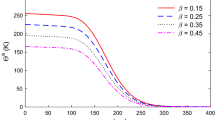Abstract
A two-component poroelastic composite material is considered. This material consists of a homogeneous transversely isotropic poroelastic matrix and aligned spheroidal inclusions filled with material having different poroelastic properties. The effective poroelastic characteristics are obtained by the effective field method. All the formulas are presented in explicit ready-to-use form.
Similar content being viewed by others
References
Berryman J.G., Milton G.V (1991) Exact results for generalized Gasman’s equations in Composite poroelastic media with two constituents. Geophysics 56:1950-1960
Berryman J.G (2006) Effective medium theories for multicomponent poroelastic composites. Journal of Engineering Mechanics 132:519-531
Biot M.A. (1941)General theory of three-dimensional consolidation. Journal of Applied Physics 12:155-164
Biot M.A (1962) Mechanics of deformation and acoustic propagation in porous media. Journal of Applied Physics 33:1482-1498
Kanaun S.K (1982) The effective field method in the linear problems in static of composite media. Applied Mathematics and Mechanics, (PMM) 46, 655-665
Kanaun, S.K. Elastic medium with random field of inhomogeneities. In: Kunin, I.A. “Elastic Media with Microstructure”, Vol. 2 (Chapter 7), Springer, 1983, 165-228.
Kazatchenko E., Markov M., Musatov A, Para J (2006) Carbonate microstructure determination by inversion of acoustic and electric data: Application to a south Florida aquifer. Journal of Applied Geophysics 59:1-15
Levin V.M., Alvarez-Tostado J.M (2004) On the effective constants of inhomogeneous poroelastic medium. Science and Engineering of Composite Materials 11(N1):35-46
Mao Bai, Elsworth D, Roegiers J-C (1993) Multiporosity/multipermeability approach to the simulation of naturally fractured reservoirs. Water Resources Research 29(N6):1621-1633
Mao Bai , Roegiers J-C, Elsworth D. (1995) Poromechanical response of fractured-porous rock masses. Journal of Petroleum Science and Engineering 13:155-168
Markov K.Z (2000) Elementary micromechanics of heterogeneous solids. In: Markov K.Z., Preziosi L. (eds). Heterogeneous Media: Micromechanics Modeling Methods and Simulation. Boston, Birkhauser, pp. 1-162
Mori T., Tanaka K (1973) Average stress in matrix and average elastic energy of materials with misfitting inclusions. Acta Metallurgica 21:571-574
Norris A (1992) On the correspondence between poroelasticity and thermoelasticity. Journal of Applied Physics 71:1138-1141
Sevostianov I, Yimaz N., Kushch V., Levin V (2005) Effective elastic properties of matrix composites with transversely isotropic phases. International Journal of Solids and Structures 42:455-476
Author information
Authors and Affiliations
Corresponding author
Rights and permissions
About this article
Cite this article
Levin, V.M., Alvarez-Tostado, J.M. Effective Poroelastic Properties of Transversely Isotropic Porous Medium with Aligned Spheroidal Inhomogeneities. Int J Fract 148, 85–92 (2007). https://doi.org/10.1007/s10704-008-9182-x
Published:
Issue Date:
DOI: https://doi.org/10.1007/s10704-008-9182-x




